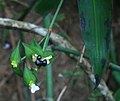From Wikipedia
Open on Wikipedia
| Tradescantia zanonia | |
|---|---|

| |
| Scientific classification | |
| Kingdom: | Plantae |
| Clade: | Tracheophytes |
| Clade: | Angiosperms |
| Clade: | Monocots |
| Clade: | Commelinids |
| Order: | Commelinales |
| Family: | Commelinaceae |
| Genus: | Tradescantia |
| Species: | T. zanonia
|
| Binomial name | |
| Tradescantia zanonia | |
| Synonyms[1] | |
|
Synonymy
| |
Tradescantia zanonia, formerly known as Campelia zanonia, is an evergreen perennial subshrub of the dayflower family, closely related to Tradescantia zebrina.[2][3] It is native to the tropical Americas, ranging from Mexico through Central America and the Caribbean to Bolivia and southern Brazil.[1] Its common names include cañagria, cascajo flor, cinta, rascadera, and suelda.[1]
Its capsule is covered by the fleshy purple-black calyx, hence a berry-like appearance.[4]
It is cultivated as a greenhouse ornamental. There is a variegated cultivar named 'Mexican Flag'.
-
Green leaves
-
'Mexican Flag'
-
A blooming plant of 'Mexican Flag'
-
Flower
-
Berry-like capsules
References
[edit]- ^ a b c Tradescantia zanonia (L.) Sw. Plants of the World Online. Retrieved 19 July 2023.
- ^ Burns, Jean H.; Faden, Robert B.; Steppan, Scott J. (2011-06-01). "Phylogenetic studies in the Commelinaceae subfamily Commelinoideae inferred from nuclear ribosomal and chloroplast DNA sequences". Systematic Botany. 36 (2): 268–276. doi:10.1600/036364411X569471. ISSN 0363-6445.
- ^ Hertweck, Kate L.; Pires, J. Chris (2014-03-01). "Systematics and evolution of inflorescence structure in the Tradescantia alliance (Commelinaceae)". Systematic Botany. 39 (1): 105–116. doi:10.1600/036364414X677991.
- ^ Hunt, D. R. (1986). "Campelia, Rhoeo and Zebrina united with Tradescantia: American Commelinaceae: XIII". Kew Bulletin. 41 (2): 401–405. doi:10.2307/4102948. ISSN 0075-5974.




